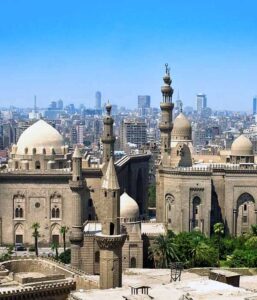Cairo, a city steeped in history and culture, is home to a remarkable array of religious sites that reflect its diverse spiritual heritage. These sites, ranging from ancient mosques to historic Coptic churches, are not only places of worship but also symbols of the city’s rich cultural tapestry. Visitors to these sacred locations can immerse themselves in the spiritual atmosphere while gaining insights into the religious traditions that have shaped Egypt over the centuries.
The Mosque of Al Azhar is one of the most significant and revered Islamic institutions in the world. Founded in 970 AD during the Fatimid Caliphate, it serves as both a mosque and a university, making it the oldest degree-granting university still in operation. The mosque is located in El Hossein Square, a vibrant area that pulses with religious and cultural activities. Al Azhar is not just a place of worship; it is a symbol of Islamic scholarship and learning, attracting students and scholars from around the globe.
The mosque’s architecture is a stunning example of Fatimid, Mamluk, and Ottoman styles, with its five minarets, vast prayer halls, and intricate mihrab (prayer niche). The mosque has undergone numerous renovations and expansions over the centuries, each adding to its grandeur and historical significance. Al Azhar remains a central figure in the Islamic world, influencing religious thought and practice across the Muslim community.
El Hossein Square, where the mosque is situated, is named after the grandson of the Prophet Muhammad, whose shrine is also located in the area. The square is a hub of religious activity, especially during the holy month of Ramadan, when it becomes the focal point for large gatherings and celebrations.
The Mosque of Muhammad Ali, also known as the Alabaster Mosque, is one of Cairo’s most prominent landmarks. Situated within the historic Cairo Citadel, the mosque was commissioned by Muhammad Ali Pasha, the Ottoman ruler of Egypt, in memory of his eldest son, Tusun Pasha, who died in 1816. Completed in 1848, the mosque is a striking example of Ottoman architecture and is renowned for its grand scale and stunning views over Cairo.
The mosque is constructed from alabaster-covered limestone, which gives it its distinctive gleaming appearance. Its large central dome, flanked by two towering minarets, dominates the skyline of Cairo and is visible from many parts of the city. The interior of the mosque is equally impressive, with a vast open prayer hall adorned with intricate patterns, ornate chandeliers, and a beautifully crafted mihrab.
The mosque also holds historical significance as the final resting place of Muhammad Ali Pasha, whose tomb is located inside the mosque. The site is not only a place of worship but also a symbol of Egypt’s transition from Ottoman rule to modern statehood. Visitors to the mosque can explore its rich history, admire its architectural beauty, and enjoy panoramic views of Cairo from the Citadel’s elevated position.
St. Virgin Mary’s Coptic Orthodox Church, commonly known as the Hanging Church (El Muallaqa), is one of the oldest and most important churches in Egypt. Located in the heart of Old Cairo, the church dates back to the 3rd century AD and is a key site for the Coptic Christian community. The church is called the Hanging Church because it was built on top of the southern gate of the Roman fortress of Babylon, with its nave suspended above the passageway.
The Hanging Church is renowned for its unique architectural design, blending elements of Byzantine, Roman, and Coptic styles. The church’s interior is adorned with beautiful icons, woodwork, and marble columns, many of which were salvaged from earlier churches and pagan temples. The wooden screen separating the nave from the sanctuary, known as the iconostasis, is particularly notable for its intricate carvings and inlaid crosses.
The church has played a significant role in the history of the Coptic Orthodox Church, serving as the residence of the Coptic Patriarch for centuries. It is also the site of many important events in Coptic history, including the consecration of several Coptic Popes. Today, the Hanging Church remains an active place of worship and a major pilgrimage site for Copts from around the world.
St. Mark Coptic Church, located in the Heliopolis district of Cairo, is a prominent and historic Coptic Orthodox church. Established in the early 20th century, the church is named after St. Mark the Evangelist, who is traditionally regarded as the founder of the Coptic Church and the first Patriarch of Alexandria. St. Mark’s Church serves as a spiritual and community hub for the Coptic Christian population in Heliopolis and the surrounding areas.
The church’s architecture is a blend of traditional Coptic design with modern influences, featuring domes, arches, and intricate stonework. The interior is richly decorated with religious icons, frescoes, and stained glass windows that depict scenes from the Bible and the lives of saints. The church also houses relics of St. Mark, which are venerated by the faithful.
St. Mark’s Church is not only a place of worship but also a center for religious education and social services. The church organizes various activities and programs for its congregation, including Sunday schools, youth groups, and charitable initiatives. It is a place where the Coptic community comes together to celebrate their faith, traditions, and cultural heritage.
These religious sites represent the diverse spiritual landscape of Cairo, offering a window into the rich history and culture of Egypt’s religious communities. Each site, whether Islamic or Christian, plays a vital role in the spiritual lives of the city’s residents and continues to attract pilgrims and visitors from around the world.
Exploring these sacred locations provides a deeper understanding of the religious diversity and tolerance that have characterized Egypt for centuries. The architectural beauty, historical significance, and spiritual atmosphere of these sites make them essential destinations for anyone interested in the cultural and religious heritage of Cairo.
